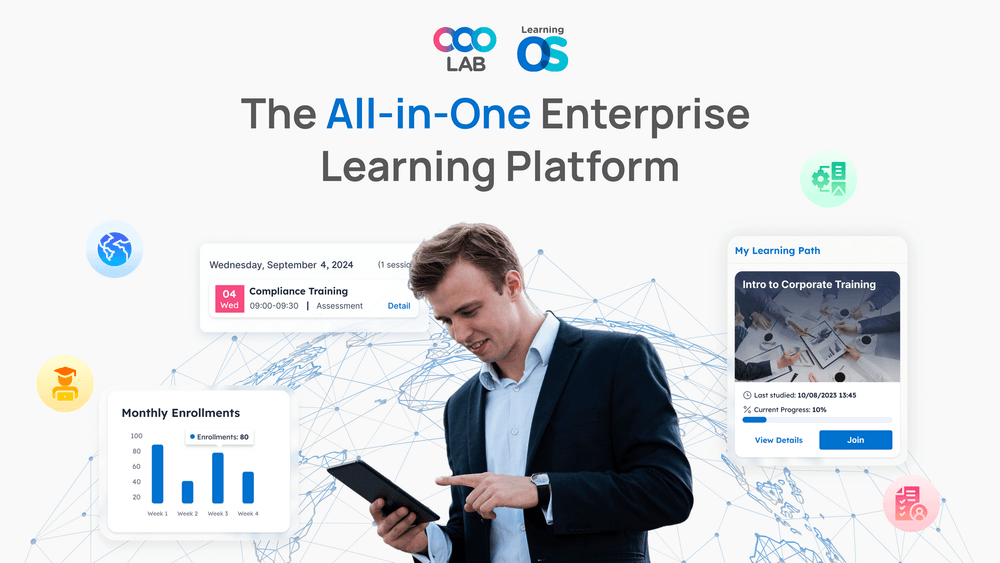

In today’s fast-evolving business landscape, developing a workforce’s skill quotient —the measure of an individual’s or team’s competency in critical skills—is essential for staying competitive. Data-driven training, powered by analytics, revolutionizes how organizations enhance their skill quotient by delivering personalized, measurable, and impactful learning experiences. By leveraging advanced analytics tools, companies can identify skill gaps, tailor training programs, and track progress with precision, ensuring optimal development outcomes.
This blog explores how data-driven training transforms skill quotient development, with practical strategies and data-backed insights. We will highlight the role of analytics in creating effective, scalable training programs.

Data-driven training uses analytics to inform every aspect of skill development, from identifying needs to measuring impact. Unlike traditional training, which often relies on generic content or intuition, data-driven approaches ensure that training is targeted, relevant, and aligned with business goals. By focusing on skill quotient development, organizations can build competencies that drive performance, innovation, and growth.
A 2024 McKinsey study found that companies using data-driven training see 25 percent higher productivity gains compared to those with traditional methods. Analytics tools enable precise interventions, making skill quotient development a strategic priority.
>>> Read more: Skill Quotient Training Tool
>>> Read more: Why Is Skill Quotient Important for Employees?
The skill quotient reflects the proficiency level of employees in key areas like technical expertise, leadership, or problem-solving. As markets shift and technologies advance, organizations must continuously enhance their skill quotient to remain agile. Analytics provide the insights needed to:
Identify skill gaps with precision.
Personalize training to individual or team needs.
Measure training effectiveness in real time.
Without analytics, training risks being misaligned or ineffective, wasting resources and stunting skill quotient growth. Data-driven training ensures learning is impactful and scalable.
Book Free Demo with us. Bring your Training and Learning to a new height with LearningOS.

>>> Read more: How To Measure Skill Quotient In Employees?
>>> Read more: Mastering Skill Quotient Measurement: Key Metrics and Strategies for Accurate Assessment
To transform skill quotient development, organizations must implement analytics-driven training strategies. Below are key approaches to leverage data for maximum impact.
Effective training begins with understanding current skill quotient levels. Analytics tools can assess performance data, employee feedback, or project outcomes to pinpoint gaps. For example, a team may show deficiencies in data analysis skills, prompting targeted training. A 2023 Deloitte report notes that data-driven skill assessments improve training relevance by 30%.
By identifying specific needs, organizations ensure training directly enhances the skill quotient.
One-size-fits-all training fails to address diverse skill levels. Analytics enable personalized learning paths by analyzing individual performance, roles, or career goals. For instance, a junior analyst might receive training on basic coding, while a senior leader focuses on strategic decision-making. A 2024 LinkedIn Learning report found that personalized training boosts engagement by 67%.
Personalization ensures skill quotient development is relevant, driving adoption and retention.
Predictive analytics forecast future skill requirements based on market trends, technology shifts, or business strategies. For example, if AI adoption is rising, analytics might recommend training to boost the skill quotient in machine learning. This proactive approach keeps workforces ahead of the curve.
By anticipating needs, organizations align training with long-term skill quotient goals, ensuring competitiveness.
Analytics provide real-time insights into training effectiveness. Metrics like completion rates, quiz scores, or on-the-job performance improvements show how training impacts the skill quotient. Managers can adjust content or delivery based on data, ensuring continuous improvement.
Real-time tracking validates training investments and drives measurable skill quotient growth.
AI-powered analytics can recommend specific training modules based on individual progress or team needs. For example, if a team struggles with collaboration, AI might suggest communication-focused training to enhance their skill quotient. This dynamic approach ensures training remains agile and effective.
AI recommendations streamline skill quotient development, maximizing efficiency and impact.
Modern learning platforms integrate analytics to deliver seamless training experiences. These platforms track learner data, provide dashboards for managers, and align training with skill quotient goals. Integration ensures analytics are actionable, driving effective skill development.
By embedding analytics in training systems, organizations optimize skill quotient outcomes at scale.
To justify training investments, organizations must measure return on investment (ROI). Analytics link training to outcomes like productivity gains, revenue growth, or reduced errors, quantifying skill quotient improvements. For example, a 20% increase in sales after training can be attributed to enhanced skills.
Data-driven ROI measurement ensures skill quotient development delivers tangible value.
>>> Read more: Social Quotient Vs Skill Quotient: A Comprehensive Analysis
>>> Read more: Skill Quotient Assessment Tools: Unlocking Employee Potential
Data-driven training transforms skill quotient development by leveraging analytics to deliver personalized, measurable, and impactful learning experiences. From assessing skill gaps to predicting future needs, these strategies ensure training aligns with business goals and workforce potential. By embracing analytics, organizations can build a highly skilled, agile workforce ready for today’s challenges and tomorrow’s opportunities.
Invest in data-driven training today to elevate your team’s skill quotient. With analytics as your guide, you can unlock unparalleled performance and drive sustainable growth.
At OOOLAB (pronounced 'uːlæb'), our mission is to make complex learning operations simple. We aim to positively impact the lives of over 1,000,000 learners and educators by the end of 2026.
OOOLAB's LearningOS provides educational institutions and corporate enterprises with an all-in-one solution to create and deliver engaging learning experiences.
We meet organizations' needs or support your growth. We provide undivided attention. We provide:
1. Dedicated success manager: We offer direct communication with a real human who'll discuss your enterprises unique learning operations and goals.
2. Personalized setup: Our team will help you transition to LearningOS on your schedule, one step at a time.
3. Around the clock support: Get help from us any time, and in any time zone.
We have recently launched a new AI training tool, Skill Quotient OS, designed to elevate hybrid training to new heights. It offers role-play exercises with scenarios and assessments. This tool can apply in sales training, corporate development and customer support training in any industry.
Reach out to us at: LinkedIn, Facebook, Instagram, Tiktok, X
1. What are the main benefits of LearningOS
Our platform is easy to use and automates all aspects of your learning operations. It efficiently manages complex tasks, allowing you to concentrate on delivering exceptional learning experiences.
2. What main features does LearningOS offer?
Our all-in-one software solution combines a Content Management System, a Learning Management System, content authoring tools, and a mobile friendly Learner Portal.
3. Can your platform be used for corporate enterprises?
Absolutely! LearningOS is an Enterprise LMS is a great fit for corporate learning. In fact, we have clients with up to 700,000 employees using LearningOS! Upskill your workforce by creating and assigning interactive eLearning content while effortlessly tracking employee progress.
4. Who currently uses your platform?
Our platform is currently used by over 120,000+ learners, parents, and employees across 21 countries worldwide!
5. What types of content options are available on your platform?
We offer ready-to-go curriculums for various educational purposes or our expert design team can build a custom course for you. We can also upload your existing learning materials and enhance them digitally.
6. What is unique about LearningOS?
Our platform, designed by educators for educators, provides you with all the tools you need to scale. Build and promote your own hybrid and blended learning courses and save money on licensing fees by owning your own proprietary content.
7. How can I get started?
Schedule a meeting with our experts and we’ll talk about how our platform can address your unique challenges and help to grow your business.